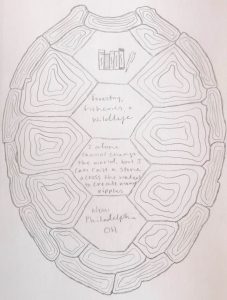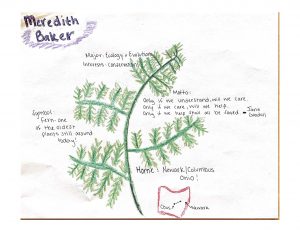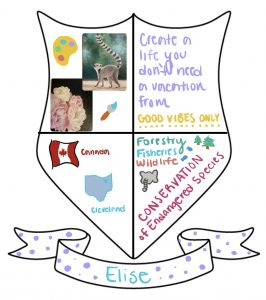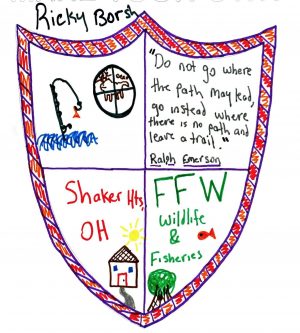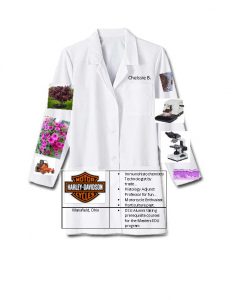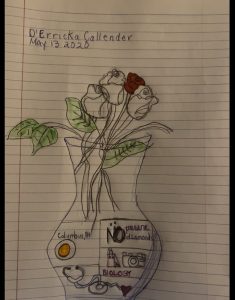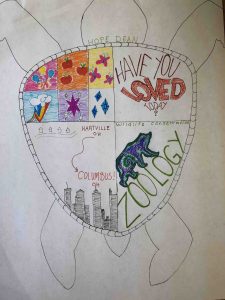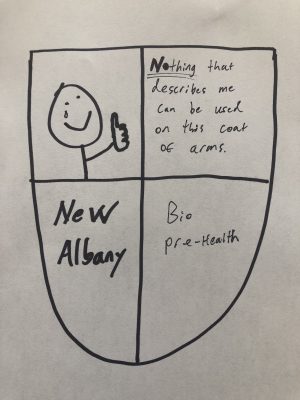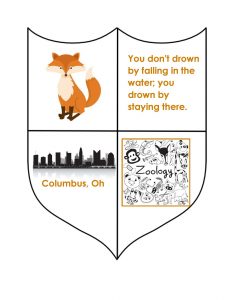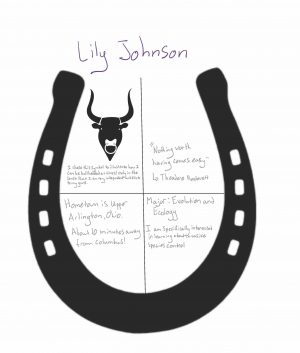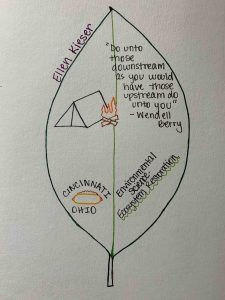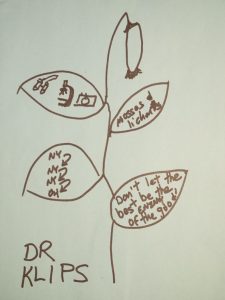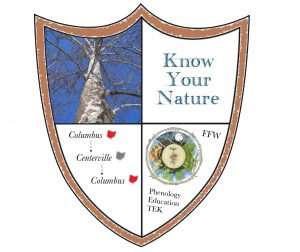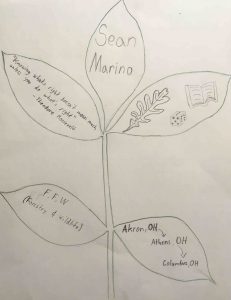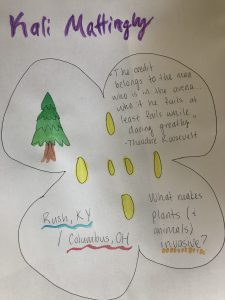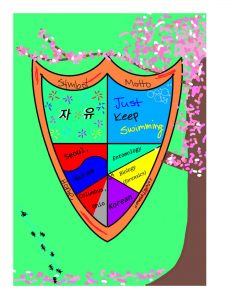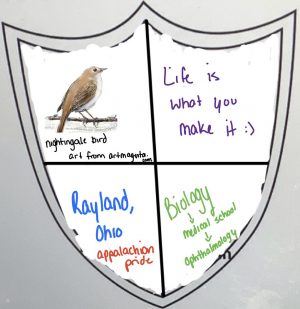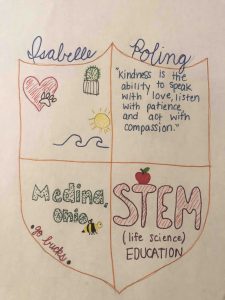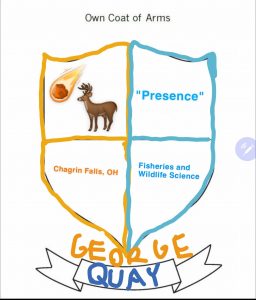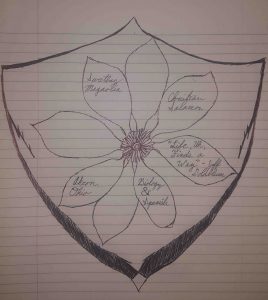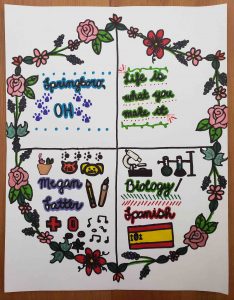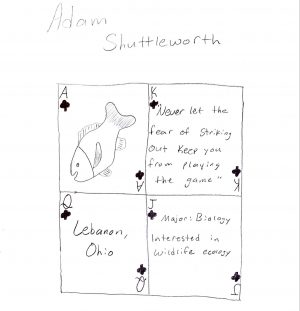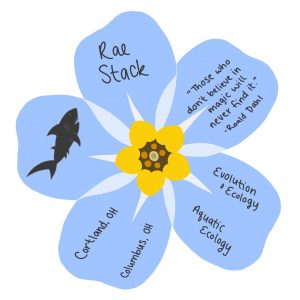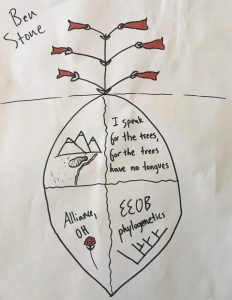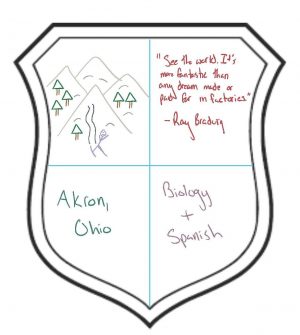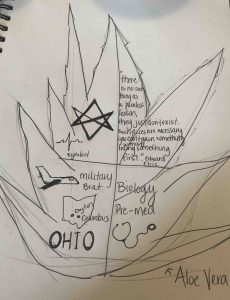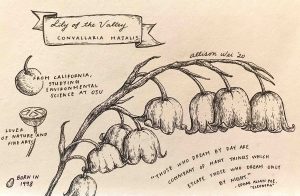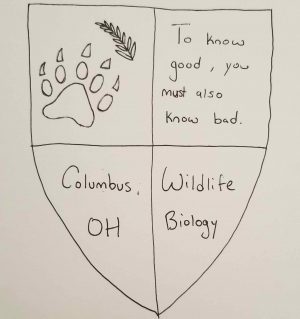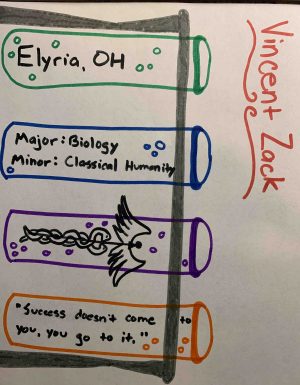Jenna A, on their PLANTS OF NORTHEAST OHIO page, explains that you don’t have to worry about hurting sensitive fern’s feelings; rather it is named “sensitive: for a different reason. What is it?
…and on their FIELD TRIPS page they show us an invasive plant that may have been useful, but tends to escape. What is the plant, and what was the “use”?
Meredith B., on their FIELD TRIPS page, describes a sedge that is easily identified because of a whimsical resemblance to something. What’s the sedge, and what’s the something?
…and on their PLANTS OF DAWES ARBORETUM page they tell us two uses of ash. What are they?
Elise B., on their FLOWERS page, found a pretty flowering plant with “grass” in its name that is totally not a grass. What is it, and why does it have that misleading name?
…and on their FIELD TRIPS page, a correctly identified moss, Plagiomnium cuspidatum. What growth form category does it fall into, and how did they recognize it?
Ricky B.,on their INTERPRETIVE SIGN, features two trees that are especially important to the ecology of Three Creeks MetroPark. What trees are they and how are they important?
…and on their FIELD TRIPS page they show a tree with insect trails left on a tree. What was being depicted there?
Chelssie B., on their COTTAGE AND RAVINE page, lists several plants along with their CC (Coefficient of Conservatism, and no, that isn’t a Death Metal Band) (very funny, Chelssie) values, the highest of which is a tree used to make a number of items that experience a lot of impact stress. What is the tree, and what are the items?
…and on their FIELD TRIPS page, they have photographed an invasive thorny plant that is not welcomed by shorts-wearers. What is the plant, and what purpose did it serve in the horticultural industry?
D’Erricka C., on their TREES page, describes the leaves of basswood and also the importance of this tree to human affairs. What are they?
… and again on their TREES page, they show us a native conifer often planted for shade. What is the tree?
Hope D., on their PLANTS OF GLEN ECHO PARK page, displays a beautiful flower that was found on a tree, of all places! What was the tree, and in what other ways is it superlative or useful?
… and on their FIELD TRIPS page, they highlight an aggressive (read: painful) little invasive plant (despite its common name) introduced to the Americas in the 1600’s. What is the plant, and from where did it originate?
Tayla E, on their TREES page, was scared at first that is was a giant poison-ivy. What was the tree, and a “fun fact” abut it?
…and on their FIELD TRIPS page, they showcase an aggressive invasive plant first imported in 1907. What is this plant, and why was it even brought here in the first place?!
Holly G., on their PLANTS OF PRAIRIE OAKS METRO PARK page, shows us a tree identified by its “wicked thorns.” What was that tree (ouch!)?
…and on their FIELD TRIPS page, they show us an easy-to-identify shrub with a correspondingly easy-to-remember common name. What is the shrub, and what is a simple way to identify it?
Max G. in their BLENDON WOODS SIGN, page, notes a design element missing from the existing signs at the park. What is that element, employed fully in their sign, and what are two ways that people can help nature that their sign advocates?
…and on their FIELD TRIPS page, they found an interesting plant with a ‘tall lanky weird shape’ (your words, Max — not mine!). What is this species, and how did Max distinguish it from another distantly related group of plants?
Rachel G., on their TREES page, oooh what a cute dog…is that a Great Pyrenees!?…now that the cute dog is out of the way, they show us a rose. How was it identified as such, and what is potentially useful about its fruits?
…and on their FIELD TRIPS page, identified a class A noxious weed which apparently makes a nice pesto. If you can’t beat ’em, eat ’em, right? What is the tasty plant?
Harley H., on their PLANTS OF ANTRIM PARK page presents an interpretive sign that promotes the park’s many features. Name two flowers, two birds, and two sports that might be enjoyed there, according to Harley.
…and on their FIELD TRIPS page, they found a moss growing on an old brick by a riverbank. What is the moss, and is it an acrocarp or a pleurocarp?
Laila H., on their PLANTS OF WHETSTONE PARK page, shows us a tree that gets its name from the sweet smell and taste that its pods have. What is the tree?
… and on their FIELD TRIPS page, they showcase another sad example of an invasive plant that was intentionally introduced in the 1800s. What is the plant, and why does it cause problems for native species?
Lily J., on their TREES page, found a tree with much more useful wood (among other useful tree parts) than the silver maple. What is the tree they found, and what are some examples of the utility of this tree’s wood?
…and on their FIELD TRIPS page, they show us more shrubs! One interesting shrub features a furry stem (pictured) and furry red fruits (not pictured). What is the plant, and what is its less fuzzy, poisonous, and more well-known close relative (same genus!)?
Ellen K., on their BOTANICAL SURVEY page, shows us a plant which is a sweet tooth’s dream! What is the plant, and why might a sweet tooth be so enamored with it?
…and on their FIELD TRIPS page, they show us the heart-shaped leaves of a seemingly ubiquitous calciphile. What is the plant, and where do these plants tend to occur (elevation wise)?
Amy K., on their PLANTS OF THE OLENTANGY WETLANDS page, shows off some ‘living fossils’. Which plants are these, and why are they given their common name?
…and on their FIELD TRIPS page, they introduce us to a ‘disease’ known as ‘leaf blotch’ or ‘leaf spot’. What causes the disease, and what plants does it affect (in this case — there are plenty of causes and hosts).
Dr. Robert K, on their FIELD TRIPS page, shows that an iris flower has 3colorful petals,3 colorful sepals and a third set or 3 colorful appendage. What is that third set that surprsingly looks rather petaloid?
…and on their FIELD TRIPS page shows an example of a moss being “poikilohydric.” What was the moss, and what was evident about it?
Conor L., on their PLANTS OF GLEN ECHO PARK page, showcases a tree with edible flowers — and they’re good for you too, containing antioxidants and vitamin C. What is this tree?
…and again on their PLANTS OF GLEN ECHO PARK page, they show us a bush that contains cephalathin, a poison that can induce vomiting. What bush can causes these nasty symptoms?
Nicoletta L., on their PLANTS OF OAK OPENINGS page, shows the showy (heh) Dames’ Rocket (Hesperis matronalis). While this flower may be pretty, it is an unwanted guest: why is that?
…and on their OAK OPENINGS page, they have created a new sign for the park they have been frequenting. According to Nicoletta, what are two plant species one is likely to see at Oak Openings?
Sean M., on their PLANTS OF SILVER CREEK METRO PARK page, presents a fine photo of a columbine. What is the genus name for this plant, and what uses does it have (though not necessarily this particular species), other than being pretty?
…and on their FIELD TRIPS page, they tell the sad story of Dutch Elm disease. What causes Dutch Elm disease, and what happens to elm trees when they get it?
Morgan M., on their PLANTS OF ANTRIM page, shows us a striped maple tree (Acer pennsylvanicum). What is so interesting about the bark of this species?
…and again on their PLANTS OF ANTRIM page, Morgan gives us some fun facts about Dame’s Violet (Hesperis matronalis). Why is this common name a misnomer (answer not on Morgan’s website), and why do people in Europe (and here, too, presumably) harvest the leaves (answer is on Morgan’s website)?
Allisya M., on their FLOWERS page, points out an invasive honeysuckle (boo!). What features about the flower of this species help differentiate it from other honeysuckle species?
…and on their TREES page we learn aboyt Kentucky coffee tree, useful as a coffee substitute perhaps but with a a couple of shortcoming; explain the shortcomings please.
Abby N., on their PLANTS OF FERNWOOD STATE FOREST page, identified an American Elm tree (Ulmus americana). Unfortunately, many of these trees are being harmed by a disease. What is the disease, and how is it spread?
…and on their FIELD TRIPS page we learn about a threat to slippery elm. What is it, including the caustivie organism(s), and how might it be treated?
Eunkhang P., on their TREES page, discusses a tree that produces notoriously smelly fruits. What is the scientific (genus, species) name of the tree, and why is it so named?
…and on their FIELD TRIPS page it is pointed out that boring insects can be controlled with a chemical. Name that chemical.
Isabelle P., on their PLANTS OF HINCKLEY RESERVATION page, presents a tree that people can use to enhance the flavor and consistency of soups and stews. What is the name of the tree?
…and what seems to be affecting the oak tree on their FIELD TRIPS page?
George Q., on their POSTER page, details some interesting information about the formation of Iuka Ravine. How was Iuka Ravine formed, and how long ago, according to George?
…and on their PLANTS OF IUKA PARK page we learn that Carya cordifornis has an apt common name. Name it, and say why it’s called that.
Christian S., on their PLANTS OF FIRESTONE METRO PARK page, describes a plant that is entirely toxic, except for the fruit (although that too is toxic in large quantities). What plant is this, and what is interesting about how colonies of it can form?
…and n their FIELD TRIPS page we meet (eek!) one of the worlds worst invasive species, capable of endangering not just ecosystems but whaaaat? (Name the plant too, please.)
Megan S., on their TREES page, gives us some handy hints to differentiate the yellow and Ohio Buckeye. What species did Megan find, and how could she tell the two apart?
…and on their PLANTS OF WHETSTONE PARK page, we learn about several uses of basswood wood (wood wood; that sounds funny). What would they be?
Adam S., on their PLANTS OF CAESARS CREEK page, created a sign to notify readers about the importance of butterflies in the area. What kind of butterfly is on the sign, and what is one family they often pollinate, according to Adam?
…and they found two invasive plants at Cowan Lake, displayed on the FIELD TRIPS page. What are these plants?
Rae S., on their TREES page, shows us an American Hackberry (Celtis occidentalis). What are the fruits of these plants called, and what likes to eat them?
…and on their PLANTS OF SCIOTO AUDUBON METROPARK page they found a shrub that is perfect for a bird park! What was that perfect shrub, and how is is used by humans as well?
Cameron U., on their PLANTS OF VIRGINIA KENDALL page, shows us a tree that can be used to make cough syrup, and treat symptoms of typhoid and malaria! What is this tree, and how would one make such medicines?
…and on their FIELD TRIPS page we see an invasive tree. What is the tree, where is it from originally, and how might if be controlled?
Arlene V., on their BATTELLE DARBY CREEK page, shows us a cool vine that looks suspiciously like poison ivy. What features did Arlene use to tell it was not poison ivy, and what actually is the vine in question?
…and on their TREES page one of them is identified in part using a twig feature that is just as well seen in the winter. What’s the feature; what;s the tree?
Allison W., on their TREES page, presents an American Sycamore. These trees can live a long time! How old can American Sycamores get, and what often happens to their trunks when they do, according to Allison?
…and on their FIELD TRIPS page we see a very un-fernlike fern. What is the fern, what it its habitat/substrate, and what does it look like?
Derek W., on their PLANTS OF HIDDEN VALLEY page, shows us a Sassafras tree (Sassafras albidum). What makes this tree so easy to identify, and what useful service does it provide if you’re being chewed up by insects, according to Derek?
…and on their FIELD TRIPS page we are told of a way to recognize a shrub, honeysuckle, using a winter botany (twig) feature. How so?
Vincent Z., on their PLANTS OF HIGHBANKS METRO PARK page, shows us some photographs of a shagbark hickory (Carya ovata). The wood of this tree ain’t too shaggy (instead of shabby? Funny?), and has, in the past, according to Vincent, been used to construct what?
…and on their TREES page we learn of the wildlife benefits of American hornbeam. What are they?
LINKS TO WEB SITES

